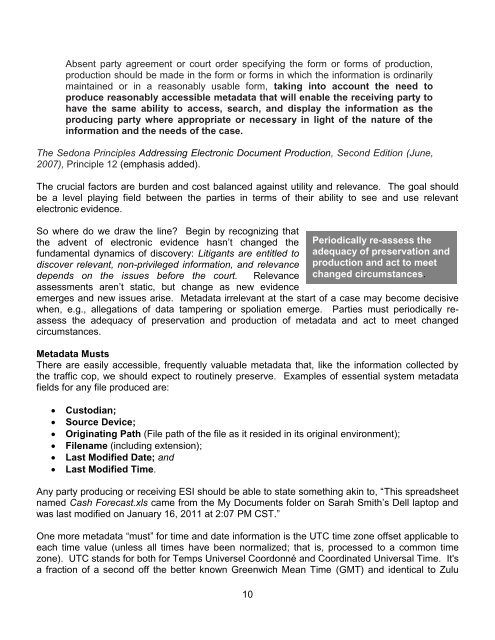Litigator's Guide to Metadata - Codemantra.net
Litigator's Guide to Metadata - Codemantra.net
Litigator's Guide to Metadata - Codemantra.net
- No tags were found...
You also want an ePaper? Increase the reach of your titles
YUMPU automatically turns print PDFs into web optimized ePapers that Google loves.
Absent party agreement or court order specifying the form or forms of production,production should be made in the form or forms in which the information is ordinarilymaintained or in a reasonably usable form, taking in<strong>to</strong> account the need <strong>to</strong>produce reasonably accessible metadata that will enable the receiving party <strong>to</strong>have the same ability <strong>to</strong> access, search, and display the information as theproducing party where appropriate or necessary in light of the nature of theinformation and the needs of the case.The Sedona Principles Addressing Electronic Document Production, Second Edition (June,2007), Principle 12 (emphasis added).The crucial fac<strong>to</strong>rs are burden and cost balanced against utility and relevance. The goal shouldbe a level playing field between the parties in terms of their ability <strong>to</strong> see and use relevantelectronic evidence.So where do we draw the line? Begin by recognizing thatthe advent of electronic evidence hasn’t changed thefundamental dynamics of discovery: Litigants are entitled <strong>to</strong>discover relevant, non-privileged information, and relevancePeriodically re-assess theadequacy of preservation andproduction and act <strong>to</strong> meetchanged circumstances.depends on the issues before the court. Relevanceassessments aren’t static, but change as new evidenceemerges and new issues arise. <strong>Metadata</strong> irrelevant at the start of a case may become decisivewhen, e.g., allegations of data tampering or spoliation emerge. Parties must periodically reassessthe adequacy of preservation and production of metadata and act <strong>to</strong> meet changedcircumstances.<strong>Metadata</strong> MustsThere are easily accessible, frequently valuable metadata that, like the information collected bythe traffic cop, we should expect <strong>to</strong> routinely preserve. Examples of essential system metadatafields for any file produced are:Cus<strong>to</strong>dian;Source Device;Originating Path (File path of the file as it resided in its original environment);Filename (including extension);Last Modified Date; andLast Modified Time.Any party producing or receiving ESI should be able <strong>to</strong> state something akin <strong>to</strong>, ―This spreadsheetnamed Cash Forecast.xls came from the My Documents folder on Sarah Smith’s Dell lap<strong>to</strong>p andwas last modified on January 16, 2011 at 2:07 PM CST.‖One more metadata ―must‖ for time and date information is the UTC time zone offset applicable <strong>to</strong>each time value (unless all times have been normalized; that is, processed <strong>to</strong> a common timezone). UTC stands for both for Temps Universel Coordonné and Coordinated Universal Time. It'sa fraction of a second off the better known Greenwich Mean Time (GMT) and identical <strong>to</strong> Zulu10













